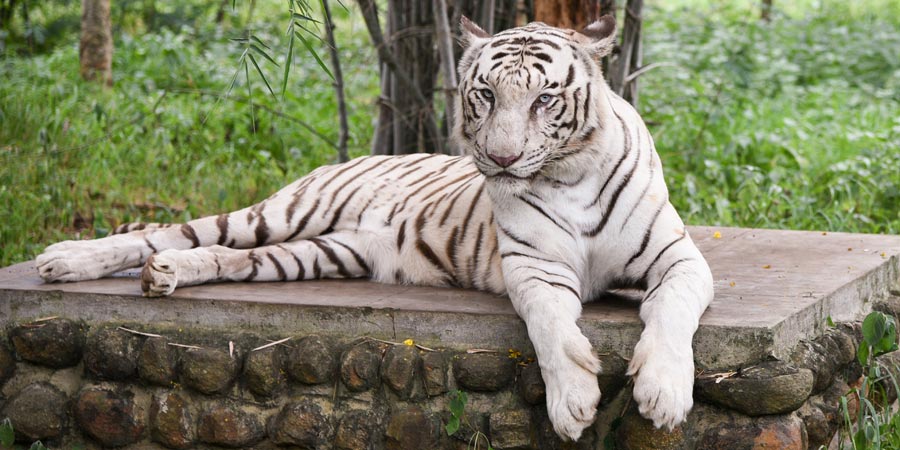Majestic and beautiful, the tiger is without a doubt one of the world's most adored and iconic wild animals. But, its numbers are dwindling, and with only around 3,900 tigers remaining in the wild today, conservation and awareness are more important than ever. International Tiger Day is celebrated each year on July 29th. It was formed at the 2010 Saint Petersburg Tiger Summit with the aim to raise public awareness, help protect and conserve tiger's natural habitats, and ultimately, double the number of tigers in the wild to over 6,000 by the year 2022 - fittingly, the next Chinese year of the tiger. Over the past seven years, International Tiger Day has been celebrated by communities across the world, seeing people come together to raise awareness for these beautiful endangered creatures. In honour of International Tiger Day this Sunday, this week's blog post is dedicated to the stunning tiger; as we look at the legacy of the big cat, the best destinations to spot a tiger in the wild, and the future of the species moving forwards.
Legacy and culture
As a symbol of beauty, power and strength, tigers have been the subject of much fascination since ancient times. The largest of the big cats and one of the most instantly recognisable creatures worldwide, the tiger is an example of a charismatic megafauna or flagship species. Defined as a "large animal species with a widespread popular appeal, which are often used by environmental activists to achieve environmentalist goals" this group, which also includes elephants, lions and giant pandas, have a broad and enduring appeal. Indeed, tigers are one of the first animals that many of us will learn about as a young child. As a symbol of strength, courage and power, they feature heavily in folklore and mythology and are utilised throughout popular culture today as mascots, characters and media motifs.
The tiger is an important figure in Chinese culture, considered the king of all beasts and a symbol of great power. In popular Chinese myth and culture, the tiger is one of the 12 animals of the zodiac, symbolising confidence, charm and tenacity. Conversely, in Buddhism, the tiger is one of Three Senseless Creatures said to be ruled by undesirable human emotions, and symbolises rage and anger. In Western culture, tigers appear prominently throughout films, books, cartoons and advertising. Shere Khan, the main antagonist of Disney's The Jungle Book, based on Rudyard Kipling's 1894 novel, is depicted as arrogant, intimidating and powerful. While many portrayals of tigers within popular culture highlight their dominant and powerful nature, their popularity is also utilised in a more light-hearted fashion - Tigger, in A.A Milne and Disney's Winnie the Pooh is portrayed as bouncy and playful, and Kellogg's enthusiastic cartoon character Tony the Tiger is perhaps one of the most iconic advertising mascots of our time.
Where to spot tigers
While tigers can be found in captivity in zoos around the world, seeing a tiger, or indeed any endangered animal in their natural habitat is an unrivalled experience, not to mention the most ethical. But, where to go? Tigers still exist in the wild in Asia and can be found in India, Nepal, Indonesia, Russia and China.
Ranthambore National Park, India
Incredibly, India is home to over half of the world's tiger population, and with 49 tiger reserves it is an excellent destination for big cat lovers. Ranthambore National Park in Rajasthan is renowned as one of the best places in the world to spot wild tigers. It was declared as one of the Project Tiger reserves in 1973 and is a favourite of wildlife photographers and tourists alike due to its large tiger population. Lucky visitors have the chance to embark on a game drive where they may spot the elusive Bengal tiger basking in the sun or sauntering through the wilderness.
Chitwan National Park, Nepal
Established in 1973, Chitwan National Park was the first national park of Nepal and became a UNESCO World Heritage Site in 1984. A sprawling area filled with lush grassland and subtropical rainforest, it is a fantastic place to spot some magnificent wildlife, including protected rhinoceroses, crocodiles, and of course, the rare Bengal tiger.
Moving forwards
Tigers are a vulnerable species, with a number of factors that contribute to the decline in their numbers, including poaching and hunting, climate change, and damage to their natural habitats. While organisations such as India's Project Tiger and the World Wildlife Fund are taking important steps to help with conservation, there are simple steps that we can all take to help. Many people are unaware that there are as few as 3,900 tigers remaining in the wild, so simply spreading the word is an easy, cost-free way to raise awareness. The illegal wildlife trade is an enormous threat, with tigers killed in huge numbers for their skins, bones and meat. It goes without saying that products derived from tigers should be avoided, including furs, jewellery made from claws or teeth, and traditional medicines which contain tiger derivatives. Finally, thinking green and transforming our lives to ensure that we are reducing pressure on natural resources wherever possible can make a huge difference to the natural habitats of endangered creatures.
Here's the great news: conservation efforts in recent years has meant the number of tigers in the wild has risen for the first time in 100 years. However, there is still a long way to go to achieve the ambitious goal of 6,000 wild tigers by 2022. International Tiger Day serves as a yearly reminder of the importance of the conservation of this majestic creature, and a poignant affirmation that together, we can truly make a difference.






